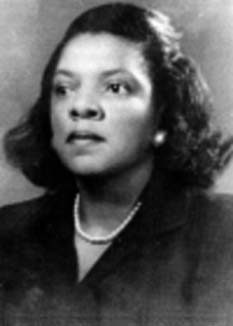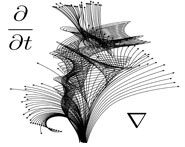


 تاريخ الرياضيات
تاريخ الرياضيات
 الرياضيات في الحضارات المختلفة
الرياضيات في الحضارات المختلفة 
 الرياضيات المتقطعة
الرياضيات المتقطعة
 الجبر
الجبر
 الهندسة
الهندسة 
 المعادلات التفاضلية و التكاملية
المعادلات التفاضلية و التكاملية 
 التحليل
التحليل
 علماء الرياضيات
علماء الرياضيات |
Read More
Date: 26-11-2017
Date: 29-11-2017
Date: 17-12-2017
|
Died: 19 October 1979 in Durham, North Carolina, USA

Marjorie Lee Browne grew up and was educated in a society that was prejudicial against any African-Americans, especially women. However, Browne had a love of mathematics and was determined to study the subject to the highest possible standards. She achieved these goals and became one of the first Black women in the United States to obtain a Ph.D.
Browne was born on 9 September 1914 in Memphis, Tennessee. She was the daughter of Mary Taylor Lee and Lawrence Johnson Lee, but unfortunately Browne's mother died when she was just two years old. Instead her father, a railway postal clerk, and stepmother, Lottie Lee, a schoolteacher, raised her. Her father had also completed two years of college, which for a black man of the time was very rare. Lawrence Lee was known in the local area to be very good at mental arithmetic and it was this love of mathematics that he passed on to his daughter. Browne was also encouraged to study mathematics by her stepmother.
Lawrence Lee was more privileged than most Blacks at the time, and wished to share his good fortune with others, especially his children so he made a point of sending them to the best schools available. Browne was a pupil at LeMoyne High School. This was a private school started after the American Civil War by the Methodist and Congregational Churches with the specific aim educating Black people. By the time Browne left high school she was not only known as a gifted maths student, but also a noted tennis player.
Browne's years at university coincided with the Depression. However, she could afford to attend Howard University in Washington D.C, due to a combination of loans, jobs and scholarships. In 1935 Browne received her B.S. degree from Howard, where she graduated cum laude. Following graduation she taught mathematics and physics at Gilbert Academy in New Orleans, Louisiana, a private secondary school for Black students. However, Browne only kept this post for one year as she then enrolled at the University of Michigan, in Ann Arbor, from where Browne gained her Masters degree in mathematics in 1939. She became one of the first women to receive this advanced degree. Upon this she became a member of the teaching staff at Wiley College, in Marshall, Texas, between 1942 and 1945. During the summer breaks Browne started work on her doctorate at the University of Michigan.
Over the years there have been conflicting opinions regarding the year in which Marjorie Lee Browne gained her Ph.D. from the University of Michigan. Browne had become a teaching fellow at the University of Michigan in 1947. All the requirements for a Ph.D. were completed in 1949, but the earliest graduation ceremony was not until February 1950. In Browne's lifetime convention said that she had obtained her Ph.D. in 1949, however, in 1999 some references changed the date to 1950. At this time she was referred to as being only the second African-American women to gain a Ph.D., Evelyn Boyd Granville being the first. No matter which stance is taken Browne was still one of the first two African-American women to obtain a Ph.D. in mathematics. Her thesis was titled On the One Parameter Subgroups in Certain Topological and Matrix Groups, which was written under the supervision of G Y Rainich.
In 1949, Browne joined the faculty of mathematics at North Carolina Central University, then called North Carolina College, where she stayed until her retirement in 1979. For 25 years she was the only person in the department to have a Ph.D. She became Chair of the Mathematics Department in 1951, a post she retained until 1970. Browne taught for 15 hours a week, teaching both undergraduate and postgraduate courses. Also during her time at NCCU Browne supervised 10 masters degrees.
Between 1952 and 1953 Browne won a fellowship from the Ford Foundation. This is an organisation that offers grants to innovative people and institutions worldwide. Examples of the areas for which grants can be obtained are asset building and community development, education, media, arts, culture, peace and social justice as well as others. Browne's grant allowed her to study combinational topology at Cambridge University. This also provided her with the opportunity travel throughout Western Europe. Brown was also a National Science Foundation Faculty Fellow studying computing and numerical analysis at the University of California at Los Angeles. She won a similar fellowship while studying differential topology at Columbia University, New York, in during 1965 - 66.
In 1960 Browne was the principal author of a successful proposal that won a grant from IBM, which allowed the NCCU to obtain its first computer for use in academic computations. She was also the overseer of its installation. She also obtained, in 1969, for her department the first Shell Grant for awards to outstanding mathematics students. While at NCCU Browne held positions other than that of department chair. These were Principal Investigator, Coordinator of the mathematics section and Lecturer of the Summer Institute for secondary school science and mathematics teachers.
During the summer Browne was occupied with instructing secondary school teachers. Due to her leadership in this scheme NCCU became the first institution primarily for Black people in the United States to be granted the funds for a National Science Foundation Institute for secondary teachers of mathematics. For 13 years Browne served as director of the mathematics section of these Institutes. Four sets of lecture note were written by Browne to be used by these teachers. These notes were Sets, Logic and Mathematical Thought (1957), Introduction to Linear Algebra (1959), Elementary Matrix Algebra (1969), andAlgebraic Structures (1974). Due to this work for the continuation of education for secondary teachers, Browne became the first recipient, in 1975, of the W W Rankin Memorial Award for Excellence in Mathematics Education, given by the North Carolina Council of Teachers.
Browne's other published work was her paper A Note on the Classical Groups. This was published in the American Mathematics Monthly in 1955. The purpose of the paper was to set forth some topological properties and the relations between certain classical groups.
During the latter part of her life Browne used much of her own money to help gifted mathematics students to continue their education. Marjorie Lee Browne died at her home in Durham, North Carolina, of a heart attack, on the 19 October 1979. She was 65 years of age. She will be remembered for helping any student that came to her prepare for and complete their Ph.D.'s, encouraging them to do what she had achieved.
Articles:



|
|
|
|
4 أسباب تجعلك تضيف الزنجبيل إلى طعامك.. تعرف عليها
|
|
|
|
|
|
|
أكبر محطة للطاقة الكهرومائية في بريطانيا تستعد للانطلاق
|
|
|
|
|
|
|
أصواتٌ قرآنية واعدة .. أكثر من 80 برعماً يشارك في المحفل القرآني الرمضاني بالصحن الحيدري الشريف
|
|
|